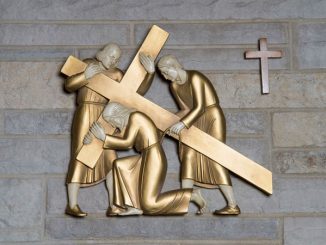
Teaching Holy Week to second graders is a bit like herding cats: daunting, if not impossible, without the guidance of the Holy Spirit.
I’ve made many mistakes when teaching Holy Week. In the past, I’ve attempted to cram the principles of the Triduum and Easter on the last Sunday of class before Easter break (which happens to be Palm Sunday). I did this because I wanted to make sure I had enough time to prepare the children for their First Holy Communion. I would cram Salvation History and the miracle of the Resurrection in 90 minutes. Their eight-year-old minds must have been spinning. But as soon as I remembered that the Easter season was 50 days long, I realized that I could relax. I felt the freedom to focus the Holy Week lesson on our relationship with the person of Jesus Christ who loves us and who, even though he was the Son of God, suffered so much for us.
Another challenge I found while teaching Holy Week was sharing the details of the Passion in an age-appropriate manner. I had to remind myself that I was teaching second graders. I had great help in this area by chatting with our parish school’s second-grade teachers and by consulting the many resources offered by Loyola Press. I quickly learned that the effectiveness of a lesson is lost when teaching at a level that is above or below the age of my students.
Learning from these past mistakes, my Holy Week lesson has evolved. When the students arrive, we now gather at our prayer space, which looks unusually barren when compared to other weeks. We still have the white cloth on our table and our crucifix at the table center, but other than two pieces of red felt (we discussed the symbolism of the red felt in an earlier lesson on the liturgical seasons), an empty bowl (normally it would be full of holy water), and a few palms, the prayer space table is devoid of all of the usual accoutrements. I give each child a live palm branch (since we live in Florida, these are easy to come by) and we talk about Jesus’ grand entrance into Jerusalem. We focus on how we would feel if we were there. We try to imagine what Jesus might have felt with such a reception, the sights, smells, and events of such a time. We march around the room with our palms and imagine that we are in Jesus’ midst. I play an upbeat version of children singing “Hosanna!” The students join in singing, reading from song sheets that I had passed out earlier.
After this, we talk about the events of Holy Week and their significance. We engage in conversation about how the children might feel if they were there and how they think the key characters might have felt: Jesus, his Blessed Mother, Peter, the Apostles and other disciples, Mary Magdalene, Pontius Pilate, and the two thieves who were crucified with Jesus. The class ends with a quiet tone, seemingly unfinished. We leave waiting for the exciting victory to unfold, which will be continued at our next class when we have our big Easter celebration!
How have your lessons about Holy Week evolved over the years?




Be the first to comment